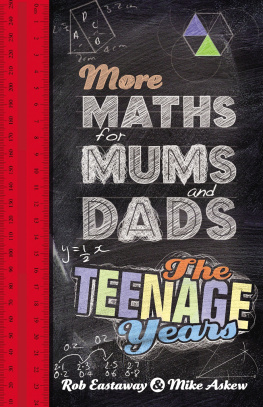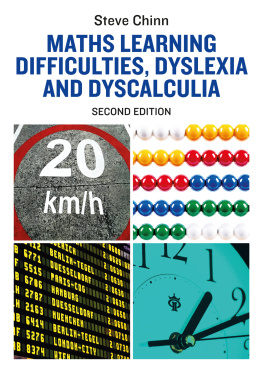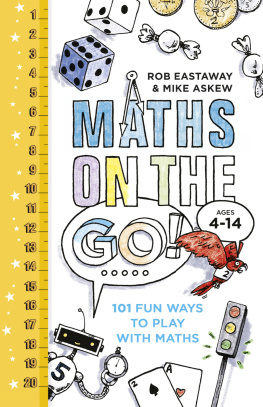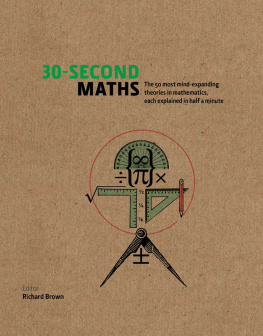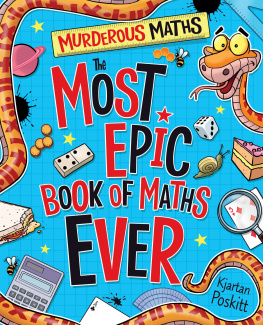Vali Nasser - Basic Maths for Adults: Everyday Maths Made Simple
Here you can read online Vali Nasser - Basic Maths for Adults: Everyday Maths Made Simple full text of the book (entire story) in english for free. Download pdf and epub, get meaning, cover and reviews about this ebook. year: 2017, publisher: xxxxxxxxxxx, genre: Children. Description of the work, (preface) as well as reviews are available. Best literature library LitArk.com created for fans of good reading and offers a wide selection of genres:
Romance novel
Science fiction
Adventure
Detective
Science
History
Home and family
Prose
Art
Politics
Computer
Non-fiction
Religion
Business
Children
Humor
Choose a favorite category and find really read worthwhile books. Enjoy immersion in the world of imagination, feel the emotions of the characters or learn something new for yourself, make an fascinating discovery.

- Book:Basic Maths for Adults: Everyday Maths Made Simple
- Author:
- Publisher:xxxxxxxxxxx
- Genre:
- Year:2017
- Rating:4 / 5
- Favourites:Add to favourites
- Your mark:
- 80
- 1
- 2
- 3
- 4
- 5
Basic Maths for Adults: Everyday Maths Made Simple: summary, description and annotation
We offer to read an annotation, description, summary or preface (depends on what the author of the book "Basic Maths for Adults: Everyday Maths Made Simple" wrote himself). If you haven't found the necessary information about the book — write in the comments, we will try to find it.
Vali Nasser: author's other books
Who wrote Basic Maths for Adults: Everyday Maths Made Simple? Find out the surname, the name of the author of the book and a list of all author's works by series.
Basic Maths for Adults: Everyday Maths Made Simple — read online for free the complete book (whole text) full work
Below is the text of the book, divided by pages. System saving the place of the last page read, allows you to conveniently read the book "Basic Maths for Adults: Everyday Maths Made Simple" online for free, without having to search again every time where you left off. Put a bookmark, and you can go to the page where you finished reading at any time.
Font size:
Interval:
Bookmark:
Basic Maths for AdultsEveryday Maths Made Simple By Vali Nasser Copyright 2014 E-book editions may also be available for this title. For more information email: All rights reserved by the author. No part of this publication can be reproduced, stored in a retrieval system, or transmitted in any form or by any means, electronic, mechanical, photocopying, recording or otherwise, without the prior permission of the publisher and/or author. ISBN-13: 978-1503052826ISBN-10: 1503052826 The author will also do his best to review, revise and update this material periodically as necessary. However, neither the author nor the publisher can accept responsibility for loss or damage resulting from the material in this book Table of ContentsIntroductionThis book is aimed at helping you do every day maths with ease. In addition, if youare applying for jobs that require basic numeracy skills then this book will also be valuable.
This will be particularly true if you want to improve your speed in Mental Arithmetic and re-visit some areas in arithmetic, especially if you did your maths a long time ago or do not feel very confident in maths.Although it is sensible to use calculators for complicated calculations it is important that you can do simple sums with confidence and ease. In addition I am sure you will want to be reminded about how to work out fractions, decimals, percentages, ratios and proportions. Everyday problems often involve being able to estimate as well as being able to work with simple formulas like Speed, Distance and Time and of course, conversions from one type of currency to another when you go on holiday! Finally, basic Statistics is useful to make sense of data that is presented visually or numerically in newspaper articles. All these topics are included in this book.The last two chapters introduce you to basic algebra and geometry in case you want to progress further in maths.Just for your information, research has shown that numerical aptitude correlates well with performance and job prospects. Although a lot of the material in the first two chapters may be familiar to you, hopefully you will find some of the Speed Methods introduced helpful for working out basic questions in arithmetic quickly. This will help you to approach basic arithmetical problems with more confidence.One thing to remember is that there is often more than one way of working out a given problem.
It does not matter which method you use, so long as you feel comfortable with it.About the Author The author of this book has experience in both consultancy work and teaching. The authors initial book Speed Mathematics Using the Vedic System has a significant following and has been translated into Japanese and Chinese as well as German. In addition, his book Pass the QTS Numeracy Test with ease is very popular with teacher trainees. Besides being a specialist mathematics teacher the author also has a degree in psychology. This has enabled him to work as an organizational development consultant giving him exposure to psychometric testing particularly applicable to numerical reasoning. Besides working in consultancy he also managed the QTS numeracy tests for teacher trainees at OCR in conjunction with the teaching agency.
Subsequently he has tutored and taught mathematics and statistics in schools as well as in adult education. He hopes that this book Basic Maths for Adults will help those aspiring to pass basic numeracy tests or just brush up their everyday skills. Chapter 1 Arithmetic part IAddition and Subtraction using Speed Methods The normal approach of column addition and subtraction is a good method and if you feel happy with it then you should have no problems with this part of arithmetic. Make sure that when dealing with adding and subtracting decimal numbers, the decimal points are aligned. Consider the Speed Method below for addition Compensating or adjusting method In this method we simply adjust by adding or subtracting from the rounded up or rounded down number as shown in the examples below. In example1 we round up 96 to 100 and adjust by taking away 4.
Similarly we round up 69 to 70 and adjust by taking away 1. See below for all the working out.Example1:
96 + 69 =
100 4 + 70 1 =
170 5 = 165Example2:
59 + 88 +23 =
60 1 + 90 2 + 20 + 3 =150 + 20 3 + 3 = 170 Basic Arithmetic Question A customer buys three items from a shoe shop, items A, B and C. The selling prices are as follows: A sells for 23.90, B sells for 33.75 and C sells for 19.95. Find the total amount the customer has to pay.Method:Total cost = 23.90 + 33.75 + 19.95= 24 - 10p + 34 - 25p + 20 5p = 24 + 34 + 20 - 10p - 25p - 5p= 78 40p = 77.60Subtraction You probably remember column subtraction and the number line method from your O level or GCSE days. Before we go on to use the Speed Method let us revisit the familiar method for subtraction. Example1:Work out: 241 - 28Traditional column method The traditional methods of subtraction serve us well in mathematics.
However, there is one more strategy that we can use to make this process much easier but more of this later. First we will consider the normal approach. Consider the following example:  Starting from the right hand side we cannot subtract 8 from 1 so we borrow 1 from the tens column to make the units column 11. Subtracting 8 from 11 gives us 3, however since we have taken away 1 from the tens column we are left with 3 in this column. Subtracting 2 from 3 in the tens column gives us 1. Speed Method of SubtractionExample1: Now consider the same problem using a Speed Method. If we add 2 to the top and bottom number we get:
Starting from the right hand side we cannot subtract 8 from 1 so we borrow 1 from the tens column to make the units column 11. Subtracting 8 from 11 gives us 3, however since we have taken away 1 from the tens column we are left with 3 in this column. Subtracting 2 from 3 in the tens column gives us 1. Speed Method of SubtractionExample1: Now consider the same problem using a Speed Method. If we add 2 to the top and bottom number we get:  You can see that subtracting 30 from 243 is easier than subtracting 28 from 241! This strategy relies on the algebraic fact that if you add or subtract the same number from the top and bottom numbers you do not change the answer to the subtraction sum. So essentially we try and add or subtract a certain number to both the numbers in order to make the sum simpler. Speed Method of SubtractionExample1: Now consider the same problem using a Speed Method. If we add 2 to the top and bottom number we get:
You can see that subtracting 30 from 243 is easier than subtracting 28 from 241! This strategy relies on the algebraic fact that if you add or subtract the same number from the top and bottom numbers you do not change the answer to the subtraction sum. So essentially we try and add or subtract a certain number to both the numbers in order to make the sum simpler. Speed Method of SubtractionExample1: Now consider the same problem using a Speed Method. If we add 2 to the top and bottom number we get:  You can see that subtracting 30 from 243 is easier than subtracting 28 from 241! This strategy relies on the algebraic fact that if you add or subtract the same number from the top and bottom numbers you do not change the answer to the subtraction sum. So essentially we try and add or subtract a certain number to both the numbers in order to make the sum simpler.
You can see that subtracting 30 from 243 is easier than subtracting 28 from 241! This strategy relies on the algebraic fact that if you add or subtract the same number from the top and bottom numbers you do not change the answer to the subtraction sum. So essentially we try and add or subtract a certain number to both the numbers in order to make the sum simpler.
A few more examples will help. Example 2: Add 4 to both numbers (we want to try to make the units column 0 in the bottom row if we can and if it helps) So the new sum is:
Add 4 to both numbers (we want to try to make the units column 0 in the bottom row if we can and if it helps) So the new sum is:  We can see that if we subtract 10 from 117 we get 107. Example 3:
We can see that if we subtract 10 from 117 we get 107. Example 3:
Font size:
Interval:
Bookmark:
Similar books «Basic Maths for Adults: Everyday Maths Made Simple»
Look at similar books to Basic Maths for Adults: Everyday Maths Made Simple. We have selected literature similar in name and meaning in the hope of providing readers with more options to find new, interesting, not yet read works.
Discussion, reviews of the book Basic Maths for Adults: Everyday Maths Made Simple and just readers' own opinions. Leave your comments, write what you think about the work, its meaning or the main characters. Specify what exactly you liked and what you didn't like, and why you think so.


